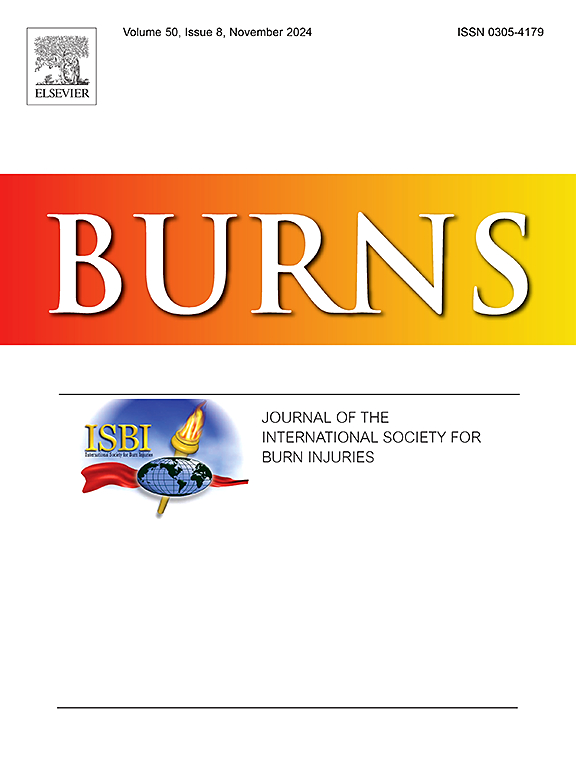面部和颈部烧伤的早期切除和后遗症:110例患者的匹配队列研究
IF 2.9
3区 医学
Q2 CRITICAL CARE MEDICINE
引用次数: 0
摘要
背景:深度烧伤的外科切除是一种挽救生命的策略,但其对长期后遗症的影响,特别是对头侧区域的影响仍未得到充分研究。这是一个严重的问题,因为面部和颈部烧伤通常会带来严重的功能、美学和社会心理后果。方法:我们进行了一项匹配的观察性队列研究,比较了早期(受伤后10天)和晚期(≥10天)接受面部和/或颈部深部烧伤手术的成年人。共筛选243例患者,根据年龄、性别、烧伤深度、烧伤总面积纳入55对配对患者。采用7天阈值进行敏感性分析。结果早期切除组的后遗症发生率为36.4% %,而延迟切除组的后遗症发生率为33.4% %。差异无统计学意义(p = 0.69)。早期切除后遗症的相对危险度(RR)为1.11(95 % CI: 0.66-1.86)。使用7天阈值的敏感性分析得出相似的RR为0.98(0.56-1.70),表明早期干预没有增加风险。结论成人面部和颈部深度烧伤早期切除(10天)不会增加长期后遗症的风险。需要更大规模的前瞻性研究来验证这些结果并进一步指导临床实践。本文章由计算机程序翻译,如有差异,请以英文原文为准。
Early excision and sequelae of facial and cervical burns: A matched-cohort study of 110 patients
Background
Early surgical excision of deep burns is a life-saving strategy, but its impact on long-term sequelae, particularly in the cephalic region, remains insufficiently studied. This is a critical concern, as facial and cervical burns often carry significant functional, aesthetic, and psychosocial consequences.
Methods
We conducted a matched observational cohort study comparing adults with deep facial and/or cervical burns who underwent early excision (<10 days post-injury) versus those treated later (≥10 days). A total of 243 patients were screened, and 55 matched pairs were included based on age, sex, burn depth, and total body surface area burned. A sensitivity analysis was performed using a 7-day threshold.
Results
Sequelae occurred in 36.4 % of patients in the early excision group versus 33.4 % in the delayed group. The difference was not statistically significant (p = 0.69). The relative risk (RR) of sequelae with early excision was 1.11 (95 % CI: 0.66–1.86). Sensitivity analysis using a 7-day threshold yielded a similar RR of 0.98 (0.56–1.70), indicating no increased risk associated with earlier intervention.
Conclusion
Our findings suggest that early excision (<10 days) of deep facial and cervical burns in adults does not increase the risk of long-term sequelae. Larger prospective studies are needed to validate these results and further guide clinical practice.
求助全文
通过发布文献求助,成功后即可免费获取论文全文。
去求助
来源期刊

Burns
医学-皮肤病学
CiteScore
4.50
自引率
18.50%
发文量
304
审稿时长
72 days
期刊介绍:
Burns aims to foster the exchange of information among all engaged in preventing and treating the effects of burns. The journal focuses on clinical, scientific and social aspects of these injuries and covers the prevention of the injury, the epidemiology of such injuries and all aspects of treatment including development of new techniques and technologies and verification of existing ones. Regular features include clinical and scientific papers, state of the art reviews and descriptions of burn-care in practice.
Topics covered by Burns include: the effects of smoke on man and animals, their tissues and cells; the responses to and treatment of patients and animals with chemical injuries to the skin; the biological and clinical effects of cold injuries; surgical techniques which are, or may be relevant to the treatment of burned patients during the acute or reconstructive phase following injury; well controlled laboratory studies of the effectiveness of anti-microbial agents on infection and new materials on scarring and healing; inflammatory responses to injury, effectiveness of related agents and other compounds used to modify the physiological and cellular responses to the injury; experimental studies of burns and the outcome of burn wound healing; regenerative medicine concerning the skin.
 求助内容:
求助内容: 应助结果提醒方式:
应助结果提醒方式:


